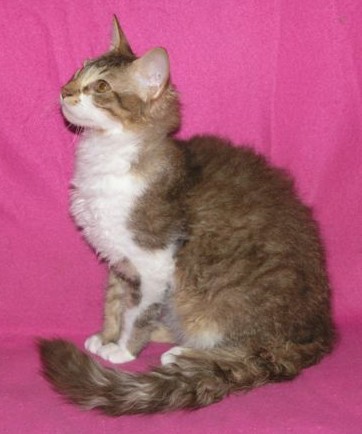Sometimes a new breed just shows up out of the blue. On a cherry orchard in March of 1982 a brown tabby gave birth to a little of six kittens. One of these kittens, a small female, was not like the others. She was a tabby, but she was long, skinny, and completely hairless. She stayed hairless until she was around six weeks old, at which time she started growing a sparse and yet curly coat. As she matured, this coat became soft and waxy.
This was the first of these interesting cats, but it wasn't the last to be born on the cherry orchard. Their owner, Linda Koehl, decided to enter six of these kittens into a cat show in her area. The judges were pleased with her kittens, so she started a breeding program that would eventually establish the foundation for the LaPerm cat breed.
At first almost all of the kittens were born bald, only later developing the curly coat that is a signature of the breed. A few were born with straight hair and kept this straight hair even as they matured. Then a kitten named Snow Fire was born. He started out with straight hair, but it shed out and was replaced with a curly coat and even curly whiskers. This was the first time that had happened, but it's since become commonplace.
It took twenty years of perfecting the breed, but the LaPerm was finally granted championship status by The International Cat Association (TICA) in February of 2003. They have since been used to create a few hybrid cats including the Skookum.
The Appearance of the LaPerm
The LaPerm is a medium-sized cat with a strong and yet slightly strange-looking body type. They can weigh up to 10 pounds and have large, cupped ears. The eyes should be almond-shaped and have a loving appearance. Any eye color is acceptable.
The most distinctive feature of this breed is, of course, the coat. Guard hairs, awn hairs, and down hairs are present, which would make the coat relatively normal if it weren't for the curls. The curls are responsible for the coarse texture. Because of these curls the coat stands away from the body. The longest hairs should be around the neck, creating a ruff effect. Even the whiskers, eyebrows, and the hairs in the ears are curly.
There is both a shorthaired LaPerm and a longhaired LaPerm. The longhaired cat has a plume to its tail while the shorthaired cat has a tail that resembles a bottlebrush. Coats are thicker and fuller in the cooler months, and older cats tend to have a more developed coat than the younger cats. All coat colors and pattern are acceptable provided the coat is the traditional LaPerm coat.
Another benefit of this coat is that it does not tangle and doesn't fall out (think poodle, but in cat form). A light brushing once a week will remove any loose hair and keep the coat bright and shining.
The Personality of the LaPerm
Unlike some of the more aloof breeds, the LaPerm loves to be around people and can be found sitting on laps, shoulders, and sometimes heads (as my son will attest to). They make incredible family cats as they are gentle, patient, and friendly. A LaPerm will generally get along well with children and other pets. They're also incredibly entertaining with their kitten like antics. A LaPerm will never grow out of this kittenish attitude.
If you're looking for a cat that doesn't shed a whole lot, is great with kids, and is a bit of a clown, the LaPerm might be for you.

No comments:
Post a Comment